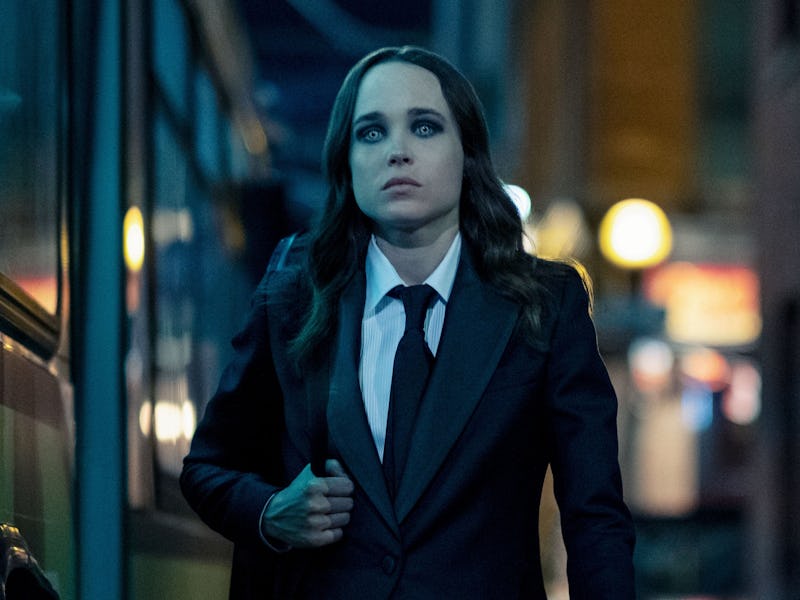Netflix’s Weirdest Superhero Show Ushered in a New Gothic Era
Before Wednesday, The Umbrella Academy made it cool to be goth.

Teens love a little gothic gloom, especially when it's done with a sleek, modern flair. Gothic films are nothing new, but the gothic dramedy that is both for, and about, teens is officially experiencing a heyday. In the past few years, numerous stylish neo-gothic tales for teens have sprung up: Netflix's Wednesday gave us a Gen Z-ified take on The Addams Family. In 2022, Jordan Peele's Wendell & Wild, another Netflix offering, brought us an animated tale about two gloomy demon brothers. This year's Lisa Frankenstein sees a teen girl falling for the living corpse of a Victorian pianist, while the upcoming Beetlejuice sequel sees a resurrection of the classic '80s Tim Burton flick about a spirit family who struggle to share their Gothic home with the new owners.
Looking back, we can probably thank Netflix's The Umbrella Academy for the rise of the subgenre. In many ways, the show set the trend for the modern teen gothic, paving the way for TV shows and films that are as stylish as they are gloomy, and as fun as they are fearsome.
Based on graphic novels by Gerard Way (frontman of My Chemical Romance) and Gabriel Bá, Netflix's The Umbrella Academy, which premiered five years ago today, is a stylish tale of supernatural superheroes. When 43 women mysteriously become pregnant and give birth only hours later, the monocled, eccentric billionaire, Sir Reginald Hargreeves, adopts seven of them, bringing them to live in his gloomy, crumbling Gothic mansion. All but one of the children grow up to have superpowers. Naturally, he raises them in his own makeshift gothic academy, training them into a troop of supernatural crime fighters.
Aesthetically, The Umbrella Academy is decidedly gothic — its color palette is all blacks and navies and purples, while shadowy, cavernous rooms are filled with obscure knick knacks, and a constant rainy haze fills the air. It fits neatly into an aesthetic tradition that first sprung up in the '80s and '90s with other cultish teen gothics like Sleepy Hollow, Edward Scissorhands, Beetlejuice, The Craft and The Addams Family.
However, while The Umbrella Academy's gloomy tone certainly fit into a long-standing tradition, it also carved its own distinctive path. The tone and aesthetic of The Umbrella Academy may have been decidedly dark, but it also worked in plenty of ultra contemporary pop culture references, awesome needle drops and slick design tricks. This was the first teen gothic with a modern sheen. In many ways, its idiosyncratic, daring take on the gothic genre opened up new possibilities for the spooky teen that have come since.
Aesthetically, it set the tone of dark academia that has become commonplace in contemporary gothic teen projects — the blazer, plaid skirt and knee high socks, complete with eerie school crest, has become the standard uniform of recent works.
The wild gothic dance didn’t just start with Wednesday.
It also reimagined the use of music and pop culture references, making daring and often downright weird choices. For instance, it included numerous weird and wonderful dance scenes, including season 1's boogie to "I Think We're Alone Now" and season 3's stoney faced Footloose dance-off. This trope has since been repeated with Jenna Ortega's now-legendary wacky prom dance in Wednesday or Kathryn Newton's unexpected rendition of "I Can't Fight This Feeling" in Lisa Frankenstein.
The Umbrella Academy also introduced contemporary teen dilemmas and concerns into the age-old genre, knowing how to combine wacky elements with sensitive explorations of human truths. For instance, the show deals unflinchingly with topics like teen anxiety and depression. It was also brave enough to handle Elliot Page's transition thoughtfully and carefully, his character ultimately becoming Viktor, his true self.
This careful blending of heightened gothic aesthetics with surprisingly honest, emotional truths speaks to newfound interest in gloomy, stylish teen shows and films. After all, they are in fact two sides of the same coin. The Umbrella Academy understands why teens keep wanting to come back to the subgenre — it's because the heightened gothic aesthetic and mood is, in many ways, the perfect home for exploring the teen experience. Like many of the gothic teen projects that have come after it, it is all about outcasts coming together and finding their place — something that teens will always resonate with.
By injecting a new sense of camp fun and sleek style into its darkness, The Umbrella Academy ushered in a new iteration of the long-standing gothic subgenre that is still going strong five years later.